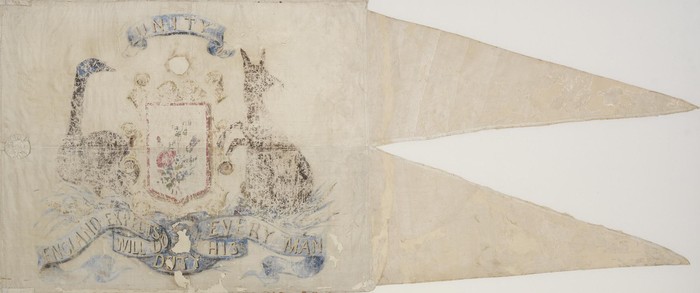The Bowman Flag, 1806
Oil
paint on silk
XR
1
The Bowman Flag is believed to be the first flag designed and
made in colonial Australia, and it is also the first known use of the
kangaroo and emu as symbols of Australia. The flag was probably designed
by John Bowman and sewn by his wife, Honor, and daughter, Mary, in 1806 to fly
at their farm Archerfield near
Richmond, NSW. It was created to celebrate the victory of Lord
Horatio Nelson and the British fleet at the Battle of Trafalgar on 21 October
1805.
The
battle was fought in the Atlantic off the southwest coast of Spain, just west
of Cape Trafalgar.
The
Franco-Spanish fleet lost twenty-two ships the British fleet lost none.
Nelson
departed from prevailing naval battle tactics – engaging the enemy fleet in a
single line parallel to the enemy – and divided his fleet into two columns
directed perpendicularly against the larger enemy fleet. Nelson was shot by a
French musketeer during the battle and died shortly after, becoming one of
Britain’s greatest war heroes.
According to the
Bowman family, the flag was made from Honor Bowman’s wedding dress. It was cut
and sewn either by Mary (aged nine at the time), John Bowman's daughter, or by
Honor, his wife. Perhaps by both.
It is unlikely that
Mary or Honor Bowman painted the image, which appears to be the work of a
professional sign painter using oil colours probably sourced from India or China.
Inspiration for the
Commonwealth coat of arms
The Commonwealth coat of arms, which bears a striking resemblance to the
Bowman flag, was granted in 1908 and was almost certainly influenced by the
Trafalgar memorial flag. Interestingly, on the Bowman flag the kangaroo and emu
are in reverse position to how they are placed on the coat of arms.
James
Woodford, Sydney Morning Herald, 21
October 2005.
Who was John Bowman?
John
Bowman (1763–1825) came from East Lothian, Scotland, and was a carpenter
experienced in building corn-mills. He came to Australia as a free settler in
May 1798 with his Cornish wife Honor, their son George and daughter Mary. He
was granted 100 acres at the Hawkesbury and later became an advocate for
Governor Bligh during the Rum Rebellion in 1808.
The
Bowman flag is one of the first recorded Australian works by a woman.
The
Battle of Trafalgar was a naval engagement fought by the Royal Navy against the
combined fleets of the French and Spanish Navies during the Napoleonic Wars.
The battle was the most decisive naval victory of the war – confirming British
naval supremacy established during the 18th century.



 Back to list
Back to list